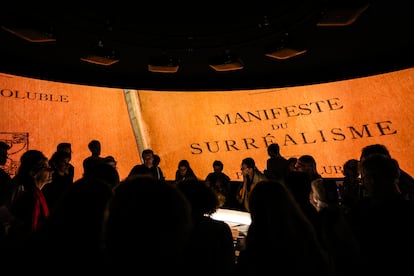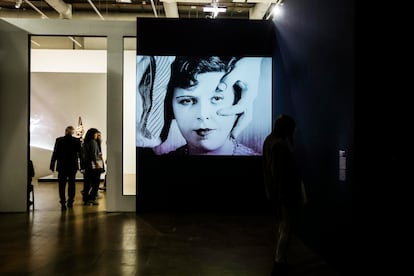The world had collapsed and a group of twenty-somethings, traumatized by World War I and alarmed by the potential for destruction that supposed progress implied, wanted to rebuild it. They proposed another way of seeing the supposed reality, convinced that there was a truth hidden beneath the surface of the visible world. “An absolute reality, a surrealism“said André Breton, its leader and main theorist. A century after the publication of the Surrealist manifesto In 1924, when this young doctor passionate about psychiatry sought to “express the real functioning of thought” and give a primordial place to “the omnipotence of the dream”, the Pompidou Centre in Paris proposed a novel reading of this avant-garde movement that alternated Marx’s desire to “transform the world” with Rimbaud’s desire to “change life”.
At the beginning of this ambitious exhibition, which opened on Wednesday and will be open to the public until January 2025, is Breton’s handwritten manifesto, purchased from his heirs in 2019 by the National Library of France and now loaned to the Pompidou. Some sentences, written in such perfect handwriting that they seem to be those of a psychopath, resonate in Breton’s (synthetic) voice, reconstructed thanks to artificial intelligence, a questionable choice for a movement that firmly opposed the industrialisation and mechanisation of society. The previous exhibition on this subject ism at the Pompidou, The surrealist revolutiontook place in 2002. Since then, academic research has revealed new insights into a movement that was less Parisian and masculine than legend suggests. An update was needed, its leaders acknowledge.
As already stated in the exhibition Surrealism Beyond Borders, On view in 2022 in London and New York, the movement managed to go far beyond the Parisian circles. It took hold in the United Kingdom, Belgium, Sweden, Italy and Spain, but also in Japan, Egypt and Latin America, which are widely represented in this new exhibition, which brings together a total of 500 works and documents. “It was an international movement that spread throughout the world, free of aesthetic dogmas and formalisms. It was a space of freedom and emancipation, a philosophy and a human adventure open to all those who wished to explore a new relationship with the world,” explains curator Marie Sarré. It was also “the avant-garde group that gave the most significant space” to women. Not enough, certainly, but more than the other isms. In the 2002 exhibition, the Pompidou only exhibited the work of three female artists. In this new exhibition, nearly 40% of the selected artists are women.

The exhibition explores the dominant themes in the different surrealist schools, from the artist as a medium in the work of Giorgio de Chirico and Victor Brauner to the flagrant influence of Freud in that of Salvador Dalí (the Dream caused by the flight of a bee It has been loaned by the Thyssen Museum, while the Reina Sofía has loaned The great masturbator), and from the murky eroticism of Hans Bellmer’s broken dolls to the interest in the cosmos in Magritte and Miró. The mixture of disparate elements that was proclaimed in Lautréamont’s famous definition (“the chance encounter of a sewing machine and an umbrella on a dissection table”) would give rise, over the decades, to mixtures as absurd and, at the same time, as lucid as that of the collages and the exquisite corpses, two quintessential surrealist exercises, along with the grattages Marx Ernst’s paintings or the decalcomanias of Oscar Dominguez (surrealism also arrived, and how, in Tenerife). The hybrid nature of the chimeras, which according to legend had a lion’s head, a goat’s belly and a dragon’s tail, is surrealist by definition, as also demonstrated by the fantastic iconography in the work of Remedios Varo, little known in France and with a leading role in this exhibition.
Surrealism was a total art that was not limited to a single discipline. It was born as a literary movement with great influence in the 20th century (Julien Gracq, Boris Vian, Julio Cortázar and even Annie Ernaux are considered to have been influenced by its aesthetics) and spread towards the visual arts, cinema and music, guided by that “convulsive beauty” so appreciated by Breton, who confronted the classicism of the 20th century and managed to bury it. The figure of the patriarch of surrealism, sometimes treated as a petty dictator who did not hesitate to excommunicate heretics – from Louis Aragon to Giacometti, including Max Ernst, who would be expelled upon accepting a prize at the Venice Biennale in 1954, a sacrilege for Breton – is more or less rehabilitated by the exhibition. Those responsible for it present him as an upright leader who opposed the commercialisation of art and the gregarious submission to political parties. “In surrealism, the artist had to be politicized, but not his art,” confirms the curator.

One of the most striking rooms is dedicated to the figure of the monster, which symbolized the political and social evils of the time. The angel of the homea painting by Max Ernst painted in 1937, seems to be a harbinger of the horrors that Europe would face a few months later. On a different scale, Dorothea Tanning, who would later become one of his wives, spoke of other monstrous figures in his installations, who seem to be possessed by sexual ghosts and childhood memories in an ominous domestic environment, sometimes covered with dusty plush, in which terrible events undoubtedly occurred. They are two of the new surrealist icons proposed by the exhibition, which does not avoid the most popular paintings and figures – there are Man Ray and Dora Maar – but counters them with lesser-known names. For example, Unica Zürn, Bellmer’s wife and author of delicate oceanic-inspired landscapes, or Ithell Colquhoun, a British woman born in colonial India, responsible for hallucinatory landscapes and excluded from the group in 1940 for her esoteric affiliations and her practice of the occult. Tate Britain will hold a retrospective next year.
At another point in a journey full of unexpected ideas, a small format by Caspar David Friedrich recalls the movement’s connection to German Romanticism and its obsession with nature and the forest, which reached as far as the jungles of Cuban Wifredo Lam, present with two works in the Paris exhibition. In other rooms, half-hidden, a work by Victor Hugo and another by Odilon Redon appear, as if suggesting that these were the putative fathers of this movement. There were other surrealists before the letter claimed by its members. In general they were heretical figures, such as Sade and Rimbaud, or lesser ones, such as Lewis Carroll, the more decadent Huysmans or a precursor of the absurd like Alfred Jarry.

The exhibition, which reproduces the form of a labyrinth, one of the surrealist tropes par excellence, delves into the complexity of a movement that, despite having dissolved itself in 1969, remains very present in contemporary culture. The stereotypes that tarnished its name, such as a link to the kitsch The exhibition, which did not always seem to have a foundation, has disappeared. “Surrealism is not dead, at least not as a way of thinking,” said Jean-Claude Silbermann, who at 89 is the last living member of the surrealist group, on the eve of the opening.
The artist was finalizing the installation of an installation inspired by Alice in Wonderland next to a work by Leonora Carrington, a self-portrait in a straitjacket that recalls her fateful days in a psychiatric hospital in Santander. After the unexpected return of figuration as the predominant language in art, today’s artists are once again defending the teachings of surrealism, the power of the marvellous and the poetic as a weapon for surviving in a world adrift. “It is no coincidence that all this is happening in times of political turbulence and the new rise of nationalism,” says Sarré. The same thing happened about a century ago.
All the culture that goes with you awaits you here.
Subscribe
Babelia
The latest literary releases analysed by the best critics in our weekly newsletter
RECEIVE IT
#surrealism #European #men #movement #changed #20th #century